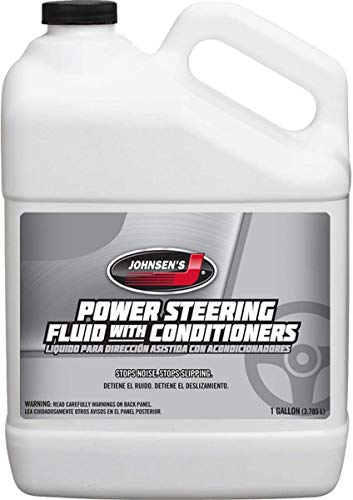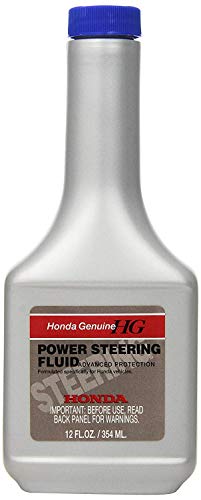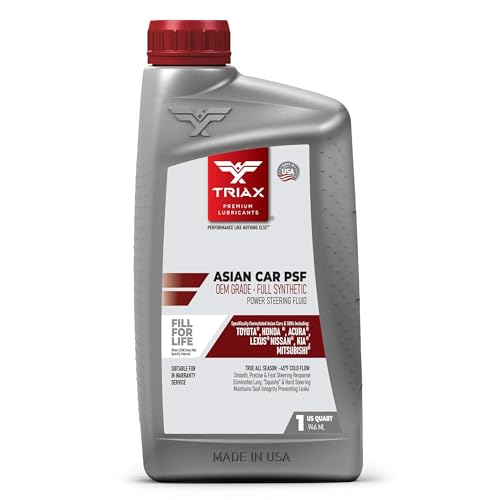When it comes to your vehicle, every fluid plays a crucial role in its performance. You might be wondering if transmission fluid can serve as an OEM equivalent for power steering.
This question is more common than you think, and the answer can impact your car’s functionality and longevity. Using the right fluids is essential for maintaining smooth steering and ensuring your vehicle operates safely. We’ll dive deep into the differences between transmission fluid and power steering fluid, and clarify whether one can truly replace the other.
By the end, you’ll have a clear understanding of what your car needs to keep running smoothly. Let’s get started!
What Is Transmission Fluid?
Transmission fluid plays a crucial role in your vehicle’s performance, but what exactly is it? Understanding this fluid helps you make informed decisions about your car’s maintenance. Let’s break down the essentials.
Transmission fluid is a specialized lubricant designed to keep your vehicle’s transmission system running smoothly. It serves multiple purposes, including lubricating moving parts, transferring power, and preventing overheating. Without it, your transmission could suffer severe damage.
Types Of Transmission Fluid
- Automatic Transmission Fluid (ATF): This is the most common type, used in automatic transmissions. It helps with gear shifting and prevents wear and tear.
- Manual Transmission Fluid: This type is thicker and provides better protection for manual transmissions. It usually has a higher viscosity.
- Dual Clutch Transmission Fluid: Specifically designed for dual-clutch transmissions, it offers unique properties for smoother gear changes.
Importance Of Quality Transmission Fluid
Using the right transmission fluid is essential for the longevity of your vehicle. Low-quality or incorrect fluid can lead to poor performance and costly repairs. Consider how often you check your fluid levels and the type of fluid you use.
Signs Of Low Or Contaminated Transmission Fluid
Be on the lookout for these signs that may indicate issues with your transmission fluid:
- Strange noises when shifting gears.
- Difficulty in changing gears.
- Unusual burnt smell coming from the transmission.
Have you ever experienced any of these symptoms? Regular checks can help you catch problems early.
How Often To Change Transmission Fluid
Most manufacturers recommend changing transmission fluid every 30,000 to 60,000 miles. However, this can vary based on your driving habits. Consider your daily commute and how often you use your vehicle. Are you driving in heavy traffic or extreme weather conditions?
Understanding transmission fluid is vital for maintaining your vehicle’s health. Your awareness can save you time and money in the long run. So, check your fluid levels and quality regularly. Your car will thank you!
Role Of Oem In Automotive Fluids
OEM stands for Original Equipment Manufacturer. These companies create parts for vehicles. They design fluids for specific car models. Their fluids meet strict quality standards. This ensures safety and performance.
Using OEM fluids helps keep vehicles running well. They match the specifications set by the manufacturer. This is important for long-term vehicle health. Non-OEM fluids may not provide the same benefits. They might even cause problems.
OEM fluids often come with warranties. This gives drivers peace of mind. It assures them that their vehicle is protected. Choosing OEM fluids can help avoid future issues.
Why Use Oem Fluids?
OEM fluids are made for specific needs. They are tested in real-world conditions. This testing ensures reliability and effectiveness. Using the right fluid can enhance vehicle performance.
Many car owners trust OEM products. They believe these products provide the best care. Non-OEM fluids may not offer the same reliability. This can lead to unexpected repairs.
How Oem Fluids Improve Performance
OEM fluids work best with OEM parts. They ensure smooth operation of different systems. This includes power steering, brakes, and engines. Using the right fluid can improve handling and response.
Each fluid has unique properties. These properties are designed to meet specific needs. OEM fluids provide optimal lubrication and protection. This helps prevent wear and tear on the vehicle.
The Impact Of Using Non-oem Fluids
Using non-OEM fluids can be risky. They may not meet the required standards. This can lead to poor performance and damage. It can also void warranties provided by manufacturers.
Car owners might save money upfront. But they may face higher repair costs later. Choosing the right fluid is key to vehicle longevity.
Power Steering Fluid Vs Transmission Fluid
Understanding the difference between power steering fluid and transmission fluid is crucial for maintaining your vehicle’s performance. Many car owners wonder if these two fluids can be used interchangeably. This blog post will clarify the distinctions and help you make informed decisions for your car’s health.
Key Differences In Composition
Power steering fluid and transmission fluid have different chemical compositions tailored for their specific functions. Power steering fluid typically contains a blend of mineral oil and additives designed to enhance lubrication and prevent foaming. In contrast, transmission fluid has a unique formulation that includes friction modifiers and detergents to handle the high-pressure environment of the transmission system.
Using power steering fluid in your transmission can lead to significant issues. It lacks the necessary additives to protect gears and prevent wear. Likewise, using transmission fluid in your power steering system may not provide the required lubrication and could result in steering difficulties.
Impact On System Performance
The performance of your vehicle hinges on using the correct fluid. Power steering fluid ensures smooth steering, allowing for precise handling. If you substitute it with transmission fluid, you might experience sluggish steering or increased effort to turn the wheel.
On the other hand, using power steering fluid in your transmission can result in slipping gears and overheating. This can lead to costly repairs and breakdowns. You want to avoid any scenario that jeopardizes your car’s reliability.
Are you using the right fluid for your vehicle? Double-check your owner’s manual or consult a professional mechanic to ensure you’re on the right track. Your vehicle deserves the best care to keep running smoothly.
Manufacturer Recommendations
Transmission fluid is not the same as OEM power steering fluid. Each type is designed for specific functions. Always check manufacturer recommendations to ensure proper fluid use for your vehicle’s performance and safety.
When maintaining your vehicle, understanding manufacturer recommendations is crucial. Many drivers wonder whether transmission fluid can serve as an OEM equivalent for power steering fluid. The answer lies in what your vehicle’s manufacturer specifies. Following these recommendations ensures optimal performance and longevity of your vehicle’s systems.Why Oem Approvals Matter
OEM (Original Equipment Manufacturer) approvals are not just a formality; they provide critical guidance for your vehicle’s needs. Using fluids that meet these approvals ensures compatibility with your vehicle’s design and engineering. For instance, your power steering system relies on specific viscosity and additives. Using a product without OEM approval can lead to inadequate lubrication. This may cause wear and tear, potentially leading to costly repairs. Always check your owner’s manual for the recommended fluids. Many manufacturers specify a particular type for a reason. Adhering to these guidelines can save you money in the long run.Risks Of Ignoring Guidelines
Ignoring manufacturer guidelines can have serious consequences. You may think that any fluid will work, but that’s a risky assumption. Using transmission fluid instead of the recommended power steering fluid can cause several issues. For example, it might not provide the right level of hydraulic pressure. This could lead to reduced steering performance and even complete steering failure. Have you ever experienced difficulty steering? It can be alarming. That struggle could stem from using the wrong fluid. In addition, your vehicle’s warranty might be affected if you use a fluid that doesn’t meet OEM specifications. This can leave you with unexpected repair bills. Take the time to understand your vehicle’s needs. Your car deserves the best, and following manufacturer recommendations is the first step in protecting your investment.Potential Risks Of Using Transmission Fluid
Using transmission fluid in place of power steering fluid can cause problems. It might not provide the right lubrication or pressure needed. This could lead to steering issues or even damage to your vehicle’s system over time. Always check manufacturer guidelines for the best fluid to use.
Using transmission fluid in place of OEM power steering fluid might seem like a quick fix, but it comes with significant risks that can affect your vehicle’s performance. Understanding these potential risks is crucial for any car owner looking to maintain their vehicle’s health. Let’s dive into the specific dangers of using transmission fluid.Damage To Power Steering Components
Using transmission fluid can lead to serious damage to your power steering system. The formulation of transmission fluid is different from that of power steering fluid. Power steering fluid contains additives specifically designed to protect seals and prevent wear. Transmission fluid lacks these crucial additives, which can cause seals to deteriorate. When seals fail, you risk leaks that can leave your power steering system dry. A dry system can lead to increased friction and ultimately, component failure.Reduced Efficiency And Longevity
Your vehicle’s power steering system relies on the right fluid for optimal performance. Transmission fluid can create a thicker consistency, which may affect how smoothly your steering operates. You might notice your steering feels heavier or less responsive. This inefficiency can put extra strain on the power steering pump, leading to premature wear. Moreover, using the wrong fluid can significantly shorten the lifespan of your power steering components. Why gamble with your car’s performance when the right fluid is readily available?When Can Transmission Fluid Be Used?
Transmission fluid can sometimes serve as a substitute for power steering fluid. Understanding when this is appropriate is important. Not every situation calls for this change. Certain factors determine if it is safe and effective.
Compatibility Scenarios
Transmission fluid might work in some power steering systems. However, compatibility is key. Some vehicles require specific fluids. Always check the vehicle’s manual first. Look for details on fluid types. If the manual allows for it, transmission fluid can be an option.
Older vehicles may be more flexible with fluid types. If your car is older, it may accept transmission fluid. Newer models often have strict requirements. Using the wrong fluid can cause damage.
Temporary Vs Long-term Use
Using transmission fluid in power steering should be temporary. This approach may help in emergencies. If you run out of power steering fluid, transmission fluid can work short-term.
Long-term use is not recommended. Transmission fluid lacks some additives found in power steering fluid. Over time, this can lead to problems. Keep an eye on performance. Always switch back to the proper fluid as soon as possible.
Alternatives To Oem Fluids
Many car owners seek alternatives to OEM fluids. These options can often save money. They may also provide similar performance. However, it’s essential to choose wisely.
Not all alternatives are equal. Some might not meet the same quality standards. Understanding the options can help you make the best choice.
Aftermarket Options
Aftermarket fluids are popular among car owners. They can be more affordable than OEM fluids. Many brands offer fluids that claim to meet specifications.
Look for reputable brands with good reviews. Check compatibility with your vehicle. Some aftermarket fluids can match OEM performance.
Synthetic Vs Conventional Fluids
Synthetic fluids are made from chemical compounds. They often provide better performance than conventional fluids. Synthetic options resist heat and breakdown longer.
Conventional fluids are petroleum-based. They are usually cheaper but may need more frequent changes. Consider your driving habits. Heavy use may benefit from synthetic fluids.
Cost Considerations
Cost plays a big role in choosing power steering fluid. Choosing between OEM and alternatives can impact your budget. Understanding these costs helps in making the right choice.
Price Differences Between Oem And Alternatives
OEM fluids are often more expensive than alternatives. This price difference comes from their specialized formulas. They are made for specific vehicle models. Alternatives usually cost less. Many brands offer similar performance at a lower price.
Some alternatives may not meet OEM standards. This can lead to issues later. Choosing cheaper options might save money now. It could cost more in repairs down the line. Weighing these costs is essential.
Long-term Cost Implications
Long-term costs can vary greatly. Using OEM fluid may mean fewer repairs. It often provides better protection for your system. This can save you from costly breakdowns.
On the other hand, cheaper fluids might wear out faster. They may not protect your system as well. This can lead to more frequent changes. More changes mean higher overall costs.
Think about the lifespan of the fluid. Investing in OEM may cost more upfront. It could save money over time through less maintenance. Carefully consider your choices to find the best value.
Expert Opinions And Case Studies
Understanding the role of transmission fluid in power steering is key. Experts have different views on this topic. Their insights help clarify the confusion around using OEM fluids. Case studies add real-world examples to this discussion.
Expert Insights On Fluid Compatibility
Many mechanics suggest using OEM fluids for power steering systems. OEM fluids meet specific standards. They ensure optimal performance and longevity. Some experts warn against using other types of fluids. They argue that using the wrong fluid can cause damage.
One expert noted, “Using transmission fluid can lead to issues. It may not provide the right lubrication. This can result in increased wear and tear.” Such opinions stress the importance of using the right fluid.
Case Studies Supporting Oem Use
Several case studies show the impact of using OEM fluids. In one case, a vehicle suffered from steering problems. The owner used transmission fluid instead of OEM fluid. The steering became stiff and unresponsive. After switching to OEM, the issues resolved.
Another study looked at long-term effects. Vehicles using OEM fluids showed fewer breakdowns. They also had lower repair costs. This evidence supports the benefits of sticking with OEM products.
Consumer Experiences And Feedback
Feedback from vehicle owners adds depth to this discussion. Many drivers report better performance with OEM fluids. They notice smoother steering and fewer maintenance issues.
One driver shared, “I switched back to OEM fluid. The difference was clear. My steering feels much better now.” Such testimonials highlight the value of using the correct fluid.
Frequently Asked Questions
Can I Use Transmission Fluid For Power Steering?
Using transmission fluid for power steering is not recommended. Power steering systems require specific fluid types for optimal performance. Using the wrong fluid can cause damage and lead to costly repairs. Always check your vehicle’s manual for the correct fluid specifications.
Is Atf A Substitute For Power Steering Fluid?
ATF can serve as a substitute for power steering fluid in some vehicles. Always check your owner’s manual to confirm compatibility. Using the wrong fluid may lead to steering issues or damage. Choose the appropriate fluid for optimal performance and longevity of your power steering system.
Do I Have To Use Oem Power Steering Fluid?
Using OEM power steering fluid is recommended for optimal performance. It meets specific requirements for your vehicle. Non-OEM fluids may cause issues or void warranties. Always consult your owner’s manual for guidance on compatible fluids. Prioritize quality to ensure the longevity of your power steering system.
What Can You Use For A Substitute For Power Steering Fluid?
You can use automatic transmission fluid (ATF) as a substitute for power steering fluid. Other options include vegetable oil or brake fluid, but these are not ideal. Always check your vehicle’s manual for specific recommendations before using any substitute. Regular maintenance ensures optimal steering performance.
Conclusion
Choosing the right fluid for your power steering system is important. OEM fluids are designed for specific vehicles. They ensure proper function and longevity. Transmission fluid may work in some cases but is not always ideal. Always check your owner’s manual for recommendations.
Using the right fluid helps avoid problems down the road. Making informed choices keeps your vehicle running smoothly. Trust the guidance from your manufacturer for the best results. This way, you protect your investment and enjoy safer drives.

Benjamin Grey is an automotive engineer and writer at Car Parts Advisor. With years of experience in the automotive industry, he shares expert advice on car parts, maintenance, and repairs to help car owners keep their vehicles running smoothly.



